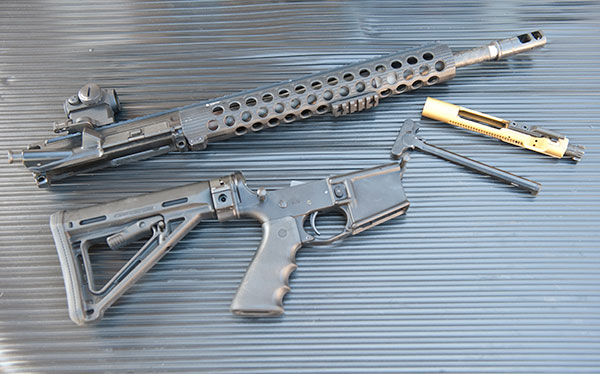Many of the folks I know who have bought an AR-15 lately know very little about maintaining them. That’s too bad because neglect and improper cleaning are responsible for many AR failures. Not to worry; these eight steps will keep your AR-15 in the fight.
1. Break It Down
Before you can clean your AR, make sure it’s unloaded and break it down to its main components. After separating the upper and lower receivers, remove the bolt carrier and disassemble the bolt, to include removing the firing pin and the cotter pin that retains it. You can also remove the trigger mechanism and handguards if you like, but I don’t unless my gun has taken a dip in mud, sand, or water. If you aren’t sure how to disassemble your AR, purchase an AR armorer’s manual or check out one of the hundreds of videos on the subject available on the Internet. The Brownells website is a good resource.
2. Clean the Chamber
Spray some cleaning solvent into the chamber and locking lug recesses of your AR, allow the solvent to sit for a few minutes, and then clean it with a chamber brush. Once that’s done, use a scrub brush to clean the locking lug recesses and then flush out the chamber with more solvent. When the chamber and locking lug recesses are nice and shiny, you can dry the area with compressed air or wipe it down with a rag before moving on to the bore. Cleaning the chamber is, in my opinion, the biggest pain, but the right solvents are a big help.
3. Scrub that Bore
The more you fire the gun, obviously, the dirtier it will get, but heat plays a major part, too. If you slow-fired a few boxes at the shooting range, your barrel doesn’t really need cleaning unless you’ve fired corrosive ammo. But if you do lots of rapid-fire work, your barrel is probably going to require some serious elbow grease and more aggressive solvents.
A bore guide and good cleaning products are must-haves. I use Shooter’s Choice or M-Pro 7 cleaners and solvents. Make sure the solvents you use are compatible; some can be dangerous or, at the very least, noxious if you combine them incorrectly. I’ve found it best to not mix brands.
Start by pushing a few solvent-soaked patches down the barrel. Let the solvent work for 10 or 15 minutes and then follow with a few dry patches. Next, apply more solvent and then run a brass brush down the bore five or 10 times. Follow that with a solvent-soaked patch to get the loose gunk out, then push a few patches that have been soaked in copper solvent down the tube and allow time for the copper solvent to do its thing.
Let your barrel tell you how much to clean it. When the patches finally come out clean, push a patch soaked with gun cleaning solvent down the bore to remove or neutralize the copper solvent. Follow that with a dry patch and you’re done, unless you’re going to store your carbine for a long period of time, in which case you should run an oil-soaked patch down the bore to protect it from corrosion.
4. Dunk It
The firing pin, cam, and bolt carrier are fairly easy to wipe clean with a rag, but the bolt itself can require some serious scrubbing and scraping, especially after high-round-count, fast-paced training sessions. Solvents and scrapers still get the job done, but the Magnum version of Hornady’s Lock-N-Load Sonic Cleaner really works well. A few months ago I ordered one, and I’m never going back to those old-school ways.
To clean my bolts and other hard-to-clean parts, I simply knock off the big stuff with a scraper, drop the bolt in the tray, and dip the tray into the solution-filled unit for 10 minutes and let it do its ultrasonic thing. Then I pull the parts out, dry them, knock off any remaining crud (it comes off very easily), and drop it in for another five minutes. When I pop the top, my small parts are usually spotless. It may take more time than scraping one bolt, but the Sonic Cleaner is faster if I have multiple guns to clean, and it gets them all much cleaner than I would manually—and with a lot less effort. If you do a lot of AR shooting, you need to own Hornady’s Sonic Cleaner.
5. Wipe It
Use a rag to wipe down the inside of the upper and lower receivers, the magazine well, and the gas port. Those areas can get surprisingly filthy, but they are easy to wipe clean with a rag. Then wipe the recoil spring and buffer assemblies and the barrel’s exterior. If you’ve removed the handguards, wipe the inside of them, too. If you plan to store your gun for any period or you operate it in a humid environment, apply a light coat of oil to the inside of aluminum handguards and the outside of the barrel before reassembly to protect those hard-to-monitor areas from corrosion.
6. Scrub the Trigger
The trigger mechanism doesn’t usually get too dirty, but it can collect gunk if you oil it too liberally or if the carbine is used in a dusty environment. I wipe mine as much as possible and then spray the mechanism down with compressed air. That usually gets the job done, but I won’t hesitate to disassemble, clean, and lubricate the trigger if it’s really dirty. Don’t tackle the trigger unless you know how or at least have a bit of mechanical ability and an AR armorer’s manual.
7. Clean Your Mags
The magazine is the weak link in every self-loader, and the AR is no exception. Be sure to disassemble your magazine and wipe down the inside of the mag body, the follower, and the spring periodically. I clean my mags once a year unless they’ve been in a harsh environment or through a carbine school, where they tend to get abused.
AR-cleaning_002
When cleanng your AR, be sure to remove the bolt carrier and disassemble the bolt, including the firing pin and the cotter pin that retains it.
8. Lube It Up
ARs must be kept wet to ensure reliability, so lubricate them liberally before you reassemble them. I use Break Free, M-Pro 7, or FP-10 by Shooter’s Choice to lubricate my carbines. Apply your chosen lubricant very liberally to the bolt body, including the gas rings, all the wear points on the bolt carrier, the cam pin, and the charging handle. A drop or two in the trigger mechanism is a good idea, too, but be sure to go light there; too much oil can collect gunk and wreak havoc on your gun’s go switch.
Once you’ve assembled your AR, cycle the action several times to distribute the oil in all the right places, perform a function check to make sure everything is assembled properly, and close the dustcover for storage.
If you take the time to do the job right and follow these eight easy steps, your carbine will never let you down.
Read more: http://www.shootingtimes.com/long-guns/how-to-properly-clean-an-ar-15/#ixzz4RWoRlACb



Leave A Comment